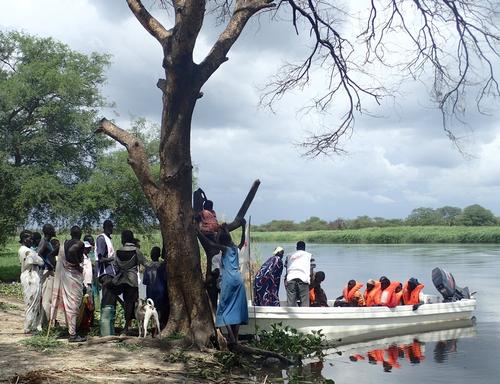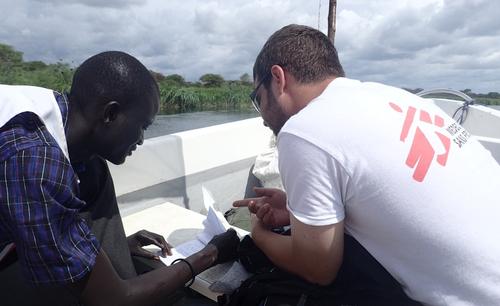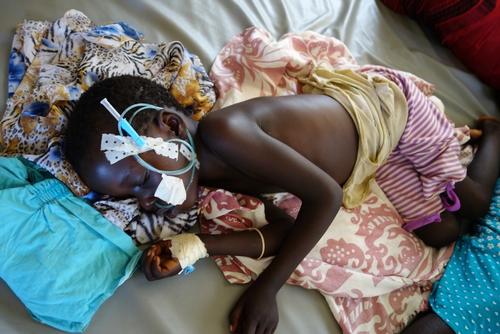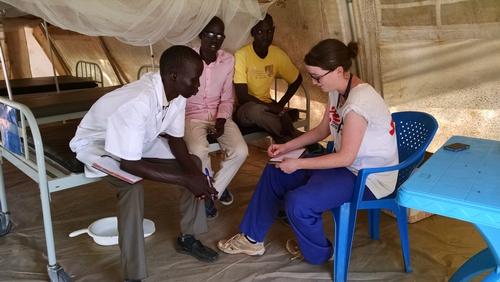It’s a late on a clear Wednesday morning and a boat coasts across the water toward the small village of Kuemdoc, on the shore of the Phom El Zaraf river. A Médecins Sans Frontières (MSF) flag flutters to the side.
A crowd of people are gathered on the riverbank, waiting under a tree, sheltering from the hot, South Sudanese sun. Others hastily make their way toward the shore as they spot the boat coming in.
People here know this boat. It’s their ambulance.
As the ambulance bumps against the riverbank, a South Sudanese community health worker jumps off and quickly begins organizing the crowd. His name is Mut.
At 33 years of age, he’s been a humanitarian worker in his own country for over a decade. He’s been working with MSF since April.
“I like to help people,” explains Mut, putting it simply.
With efficiency borne of experience, Mut begins to triage the patients gathered at the shoreline. He gently places a thermometer under the arm of a small girl who has been waiting by the shore with her mother. Even with an untrained medical eye you can see that she’s sick, listless, and in pain.
Her temperature is almost 40 degrees, likely a case of severe life-threatening malaria.
Mut helps her and her mother onto the boat, making sure that they are fitted with life jackets, and moves on to another boy.
The skin on the child’s leg is stretched taught with swelling; it’s about three times the normal size. A quick examination and discussion establishes the cause. Snake bite. As there is no anti venom available locally he also makes the referral criteria.
The boy can barely walk, but he refuses assistance getting onto the boat. He proudly hobbles on board by himself, using a stick for support.
Mut’s examinations continue for about half an hour, until he has seen each patient that’s been waiting on the riverbank, making sure that those taking up the limited spaces are those in absolute need of emergency care. Then, he steps back onto the boat, now with six patients in severe medical condition on board.
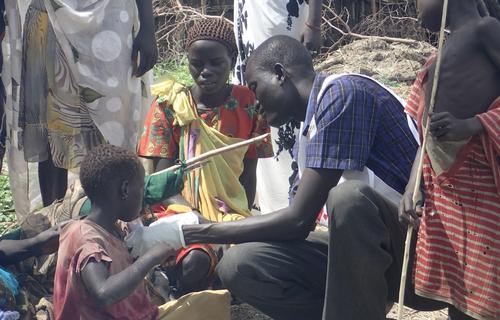
The outboard roars to life and the ambulance reverses course back down the river. Dehydration and high fever are attended to by Mut, ensuring that first line treatment is administered during the 90 minute journey.
They are heading for the hospital in Old Fangak, a remote town of about 26,000 people located deep in the dense Sudd swampland of South Sudan, stretching across two of the three conflict affected states.
The Sudd is a huge, pie-shaped expanse of soaking wet bog, extending for miles from either side of the While Nile. Its name is derived from the Arabic word for ‘barrier.’
MSF has supported a hospital in Old Fangak, the only remaining functioning hospital in Northern Jonglei since November 2014. With a small team of staff, MSF provides a range of medical services, including an emergency room, in-patient and out-patient wards, maternal and antenatal care and an intensive therapeutic feeding centre for severely malnourished children.
Since June 2015 MSF also operates an ambulance boat for outlying communities who struggle to access health care in the region, as well as people who arrived after being displaced by recent fighting in Upper Nile and Unity states.
“The ambulance boat is important,” says Mut, as it approaches the Old Fangak shoreline. “Before this system, people used to die because there was no transportation to the hospital.”
As the boat arrives to the shore, about 100 meters from the hospital the patients are brought in for treatment. It’s a trip that for many will save their lives.
“MSF is helping the wider community with this ambulance,” says Mut, who has seen first-hand protracted periods of conflict in this area extending back in time, long before South Sudan achieved independence in 2011.
Miles away in all directions from Old Fangak, conflict has been raging once again for over a year and a half, forcing hundreds of thousands of people from their homes. Many people have been displaced for months, fleeing violence and deliberate targeting of civilians with little access to medical assistance.
Most make long and difficult journeys to this region through scenes of active fighting, swamps and rivers, losing friends and family on the way, drawn to its seclusion and inaccessibility which creates a relative safe haven.
The ambulance boat has been a lifeline for some of them as well as isolated communities. Unfortunately though, it is far from capable of reaching them all.
The day before the scheduled ambulance trip, MSF was informed of a 10-year-old girl suffering from a life-threatening case of malaria. A pick up was arranged for the next day from the riverbank. On the way to Kuemdoc Mut stops at the pre arranged location to retrieve her. But when he arrives, the patient isn’t there.
No one in the community was able to carry her for the 6-hour journey to the pick up spot. After a discussion it’s arranged that the local NGO that called in the case will contact MSF if they manage to transport her to the riverbank. It’s not clear whether the girl ever made it to the hospital or if she recovered.
Sadly, this is a dilemma confronted by a lot of people here. Many who have fled conflict remain too frightened to emerge from hiding to seek help. Others, like the 10-year-old girl with malaria, are simply too far away from the river and remain inaccessible.
But Mut takes satisfaction from those he is able to help. On its first trip, the ambulance brought eight patients in severe condition to the hospital. None of them are likely to have gotten there otherwise. Since then, it has made a life-saving difference to an average of 12 patients a week. Almost 60 percent of those patients have been children under five years old.
“We are lucky here to have access to healthcare,” says Mut. “It’s making a difference.”
Two days after the trip to Kuemdoc Mut boards the ambulance boat again at 10 am in the morning. Today’s trip will take him South of Old Fangak to Toch, another community where MSF picks up emergency cases once a week. It’s another day, and he’s going to help as many patients as he can.
In South Sudan, MSF employs more than 2,800 national and around 275 international staff to respond to a wide range of medical emergencies and provide free, high-quality health care to people in need.
MSF currently operates 17 projects in six of South Sudan’s 10 states, including Unity, Upper Nile, and Jonglei, where conflict has taken a particularly heavy toll on the population. MSF also runs activities in the Abyei Administrative Area.
MSF teams respond to various health needs including surgery, obstetrics, malaria, kala azar, vaccinations against preventable diseases, and malnutrition.



